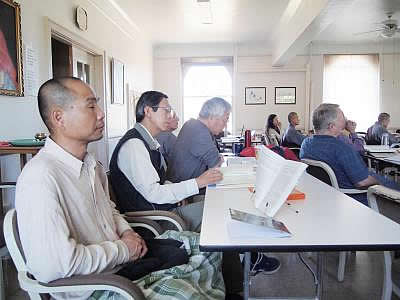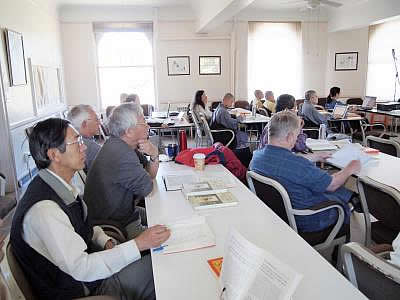
The Avatamsaka Sutra Translation at CTTB
June 20, 2011


In February, 2011, DM. Sure called on the four-fold assembly and friends of DRBA with the announcement that he planned to focus his time on the translation of the Flower Adornment Sutra. Around twenty people showed up at the first meeting on March 7, 2011 at the City of Ten Thousand Buddhas. The meeting was focused on the questions, “What do you hope to accomplish in this translation project? How can we make the best use of Venerable Master’s nine years of lecture?” “Who are the intended readers--scholars, average English readers, or those who use it for recitation?”

When the translation of the sutra text began the following week, the room was set up to motivate each person--sutra books in Chinese and English placed in front of each person, one projector ready to show the working paragraph and choice of words, another projector to show the translation tools (online Chinese/English/Sanskrit dictionaries, commentaries, CBETA and other research materials), and a person assigned to take the meeting minutes. More tasks were added as more people became involved: someone to receive those using Skype to participate, one person videotaping to record the historic event, and another to take care of the sound system. Everyone has an important role to make the sutra accessible in the West and throughout the English-speaking world.

The seriousness of this translation effort is evident from the variety of resources used to gain a thorough understanding of this sutra’s meaning. They include translation guidelines from Master Dao-an 道安 and Master Xuan-zang, as well as the commentaries by Venerable Master Hsuan Hua and Great Master Cheng - guan (Ch'eng-kuan) 澄觀 , National Master Qingliang of the Tang Dynasty.
 
Participants come from diverse backgrounds: those who are experienced in translating, those who are open to learning the translation methodology, those knowledgeable in the languages of Chinese, English, and Sanskrit, those who have studied the sutras well, and those interested in deepening their understanding of the sutra.
Even the language of English becomes an area of study, as people try to find the intricate usages or implications in a context. In each meeting, rendering the sutra into English involves careful thought and consideration from different perspectives. The factors for making the final choice of words are linguistic simplicity for recitation and linguistic elegance appropriate to the sutra, without compromising the accuracy of the sutra’s meaning.
 
Even though all have come to join voluntarily, their credentials are not mediocre. The atmosphere is of a combination of open inquiry and dynamic interchange of ideas, and it infuses the room with its own unique energy. Ideas stream in from those in the room as well as from those participating online. In the same way the sutra describes of light pouring forth, i.e. from the Bodhi Tree, sprinkles of valuable ideas and data pour forth via emails between meetings--an evidence of collective wisdom at work.
One of the challenges of translating Indic texts is the rendering of Sanskrit terms. To get a deep understanding of these foreign terms, other translations are consulted: Thomas Cleary’s Flower Ornament Sutra, the new BTTS Shurangama Sutra (2009), and an earlier Sanskrit-to-Chinese translation of the Dharma Flower Sutra [ Zhengfahua jing 正法華經 ] versus the better-known Kumarajiva’s version [ Miaofa lianhua jing 妙法蓮華經 ] . This is truly in accord with the verse for Opening the Sutra--to fathom the Tathagata’s true and actual meaning.
 
This new translation effort has brought Venerable Master's old disciples to participate in the weekly meetings, bringing their past experiences and knowledge. Prompted by DM. Sure's wish to include interns as well, novice monastics and students from Developing Virtue School have joined in to learn about the translation methodology. Indeed, it is a splendid and practical idea to train the next generation of translators to ensure the fruition of the translation of the entire sutra and other sutras as well.
Despite the recent 10,000 Buddhas Repentance session and DM. Sure's travel schedule, he made sure the meetings continued to happen, even at the early hours of 5:00-6:30 a.m. Participants still came to keep the momentum going, while DM. Sure participated from overseas. One of the meanings of the Sanskrit word “sutra” is attracting; likewise, the Avatamsaka Sutra has this power of attracting those with conditions.
This "Avatamsaka class" is indeed a wonderful way to deeply enter the Sutra.
 
 
 
 
 
 
 
 
 
 
 
 
 
Good News of Relocation for The Avatamsaka Translation Group
return to top
|

